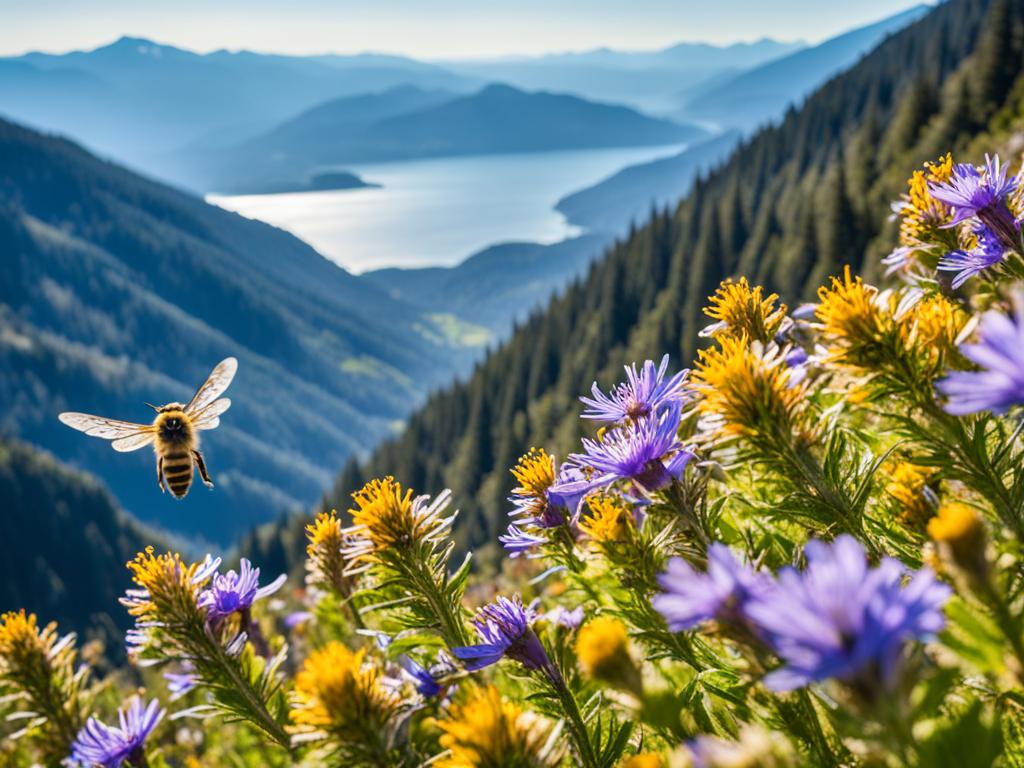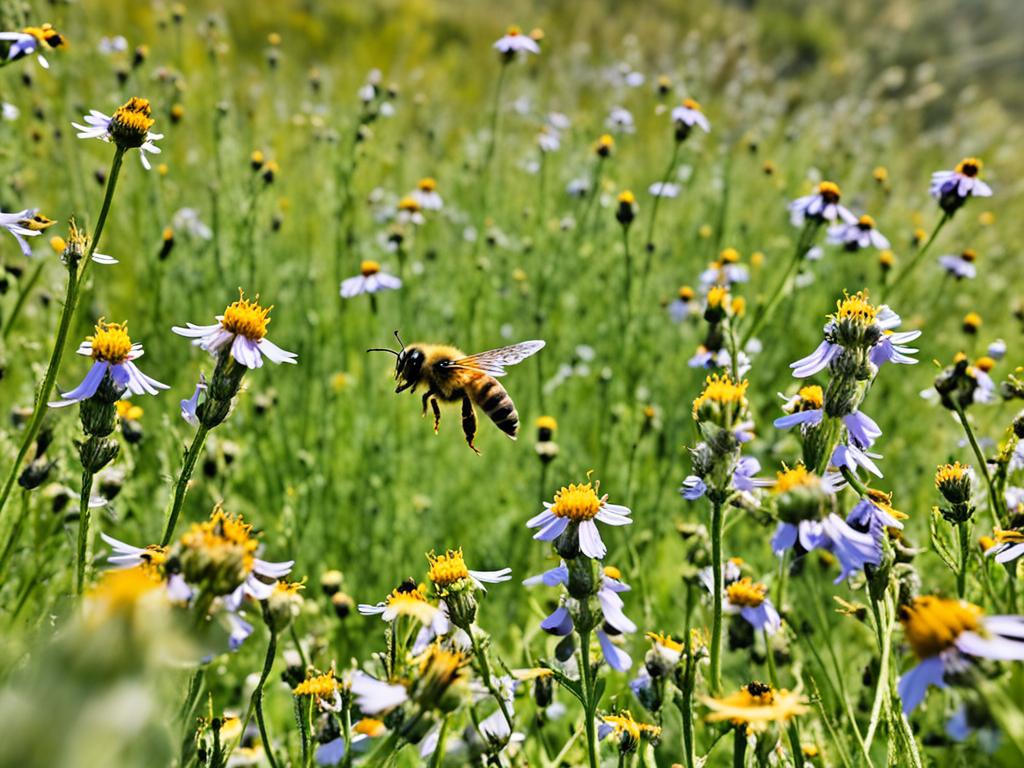Honey bees are remarkable creatures that play a vital role in our ecosystems. Understanding how far honey bees travel from their hive not only enriches my appreciation for them but is also crucial for beekeeping and conservation efforts. On average, honey bees forage approximately 3.5 to 5 miles when necessary, although they generally prefer a honey bee foraging range of just 1 to 2 miles from their hive. This foraging behavior is strategic; it allows them to efficiently collect nectar and pollen while conserving energy, which is essential for the survival of their colony.
The impact of their foraging extends far beyond their immediate surroundings, affecting agricultural productivity and the flourishing of diverse plant species. In this section, I will dive deeper into the flight abilities of honey bees and why their foraging ranges are significant to our environment.
Table of Contents
Key Takeaways
- Honey bees typically fly 1 – 2 miles from their hive in search of resources.
- Foraging bees can fly up to 4 miles for pollen and nectar.
- A single colony can access approximately 2,010 acres of land when foraging within a mile radius.
- Scout bees travel farther distances to find the best food sources and communicate their locations.
- Pollen collection generally occurs within 1 mile while nectar is usually gathered within 2 miles.
Understanding Honey Bee Foraging Ranges
Exploring the intriguing dynamics of honey bee foraging sheds light on how far these essential pollinators travel to gather resources. With their exceptional flight abilities, honey bees exhibit remarkable agility, allowing them to cover considerable distances in search of nectar and pollen. Knowledge about their flight distance helps in understanding their ecological role and benefits for agriculture.
Flight Abilities of Honey Bees
Honey bees demonstrate impressive flight capabilities, typically flying at speeds of 15 to 20 mph on their journeys. When laden with nectar or pollen, they may fly slightly slower at about 12 mph. The average bee foraging radius is generally about 1 to 2 miles from the hive, which translates to approximately 2,010 acres of land they can explore. These factors significantly affect honey bee nectar collection distance and foraging efficiency, making it essential for beekeepers to strategically place hives within optimal ranges.
The Impact of Foraging Distance on Ecosystems
The distance honey bees are willing to forage plays a critical role in their ability to provide pollination services across various ecosystems. Studies indicate that forager bees tend to remain within a two-mile radius from their hive. This close proximity ensures that bees can offer effective pollination to surrounding crops and wild flora. Understanding the relationship between body size and foraging distance provides insight into the types of bees best suited for different environments. Bees, as primary pollinators, contribute to 15-30% of the human food supply in the US, reinforcing the vital connection between honey bee foraging behaviors and agricultural productivity.
How Far Do Honey Bees Travel From Their Hive
Understanding the distance honey bees travel from their hives provides critical insights into their behavior and environmental interactions. On average, most honey bees remain within a two-mile radius. Yet, under certain circumstances, they can travel as far as five miles. This variability arises from several factors, including food availability and environmental conditions.
Average Distance and Variability
Research shows that while honey bees typically stick close to their hives, they exhibit remarkable adaptability. Here are some key points regarding their traveling ranges:
- Most honey bees forage within a two-mile radius of their hive.
- Under challenging conditions, bees may stretch their foraging distance to five miles or more.
- Scout bees play a crucial role in locating food and water, reducing the colony’s overall energy expenditure.
- Honey bees often show high floral fidelity, preferring to visit many flowers of the same species in one trip.
The Role of Food Quality in Foraging Decisions
The quality of food sources significantly influences how far will honey bees travel. They prefer abundant and rich sources over nearby, less appealing options. The implications of this choice can be outlined as follows:
- Honey bees prioritize nectar-rich flowers, even if that means traveling greater distances.
- Pollen collection typically occurs at shorter distances as many plants produce it more readily.
- Environmental factors, such as local weather and field geometry, affect how far bees must travel to pollinate crops effectively.

Conclusion
In summarizing the journey into honey bee foraging distances, it’s fascinating to witness how these remarkable pollinators navigate and make decisions that are vital for both their survival and our agriculture. Understanding how far honey bees travel from their hive showcases their extraordinary flight capabilities and strategic behaviors. As a significant contributor to U.S. agriculture, honey bees provide a staggering $14.6 billion through their essential pollination work, accomplishing 80% of the pollination for fruits, vegetables, and seeds.
Furthermore, the impressive statistics highlight the intricate dynamics at play in their bee hive exploration. A strong hive can host around 50,000 bees during peak seasons, each playing a role in the impressive feat of visiting an estimated 2 million flowers to produce just a pound of honey. The knowledge of bee foraging distance not only enriches my appreciation for these tiny architects of our ecosystem but also informs beekeepers and enthusiasts on nurturing their health and productivity.
Ultimately, reflecting on how far honey bees travel from their hive deepens my understanding of the interconnectedness within our environment. Recognizing their role as keystone species in sustaining our food supply is critical whenever we consider their protection and preservation. By cherishing these industrious insects, we acknowledge a larger responsibility to maintain the delicate balance essential for life on our planet.
FAQ
How far do honey bees typically travel from their hive?
Honey bees generally prefer a foraging radius of 1 to 2 miles from their hive but can travel up to 5 miles if necessary.
What is the average honey bee foraging range?
On average, honey bees forage approximately 3.5 to 5 miles when needed, although their optimal foraging distance is usually around 1 to 2 miles.
How does food quality affect a honey bee’s foraging distance?
Honey bees are motivated by food quality and may choose to travel farther for richer food sources rather than settle for less appealing nearby options.
What factors influence how far honey bees will travel?
Factors such as environmental conditions, resource availability, and seasonality can influence how far honey bees travel from their hive.
How does the foraging behavior of honey bees impact ecosystems?
The foraging activities of honey bees are essential for pollination, supporting agricultural productivity and the flourishing of diverse plant species.
How do honey bees’ flight abilities contribute to their foraging distances?
Honey bees can fly at speeds of 15 to 20 mph when foraging, which enables them to cover significant distances efficiently while collecting nectar and pollen.
Why is it important for beekeepers to understand honey bee foraging distances?
Understanding honey bee foraging distances helps beekeepers to place hives optimally, improving pollination efficiency and supporting healthier bee colonies.

